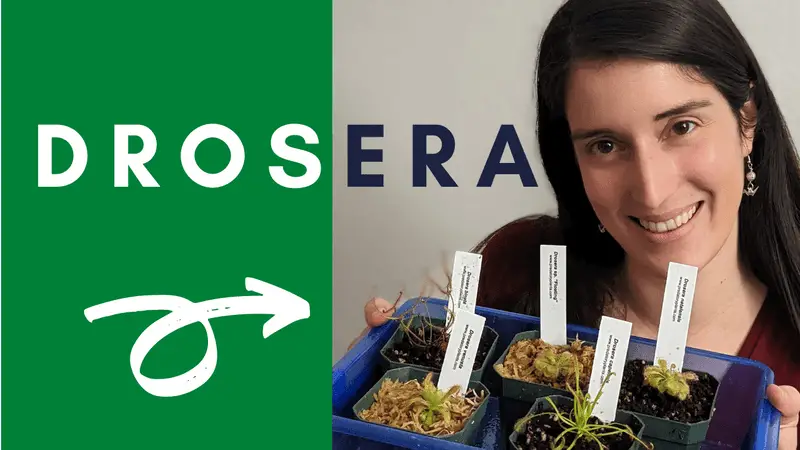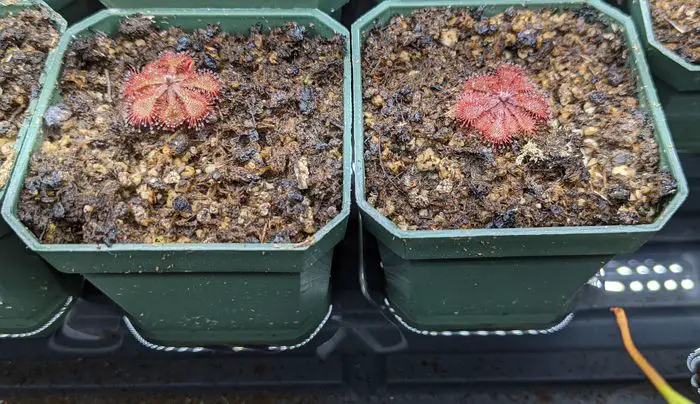
Choosing the appropriate container to grow Sundews also called Drosera is a critical part to keep them healthy. In this article, I will help you select the best pots for Sundews and give you some recommendations.
As a general rule select glazed ceramic, plastic, and resin pots for Sundews. Smaller Sundews grow well on 3-4 inch containers while larger plants prefer 5- 10 inch pots. The pots must contain enough drainage holes to avoid root rot and molding.
The size, material, and color of the pot can affect the health of your plant. Here you can find the recommended specification for choosing growing containers.
| Suitable materials | Glazed ceramic, plastic, resin, styrofoam |
| Unsuitable materials | Concrete, unglazed ceramic, clay, terra cotta, metal |
| Diameter | 3-4 inches for small rosette sundews, 5-10 inches for large sundews with leaves that grow out (like drosera binata) |
| Drainage | Must contain drainage holes |
| Color | Avoid black pots in extremely hot locations |
The Best Containers and Pots for Sundews
I have used several pots and containers that work well for carnivorous plants.
You can select any pot that meets the specifications from the table above. But, if you are looking to buy something that works right away, I recommend this pot if you are looking: https://amzn.to/3IYVGKU. Also, the pots are square which makes arranging multiple ones together very easy 🙂
The link will take you to Amazon.com, where you can check the price. They have proper drainage, and the plastic is safe for your plants. There are more expensive pots that could work too, but I tend to gravitate toward nursery plastic because of the affordability and endurance.

These are the key considerations when selecting a pot for your Sundew:
Pot Material:
When selecting a container, first inspect the material. Terra cotta, metal, clay, and concrete pots leach minerals into the soil, and those minerals are harmful to Sundews. It is difficult to estimate how much minerals will materials leach so I recommend staying away from those materials. Those minerals are usually harmless to most plants, but they are toxic for Pitcher Plants.
For best results, employ materials like plastic, resin, or glazed ceramic. Those materials are completely safe for Sundews.
Glass pots are acceptable container materials. They do not leak any type of element into the soil, but insulation can be a challenge. Make sure to avoid extreme temperatures if using metal or glass pots.
Drainage:
Avoid using containers with no drainage. It will be extremely difficult to water Sundews properly without drainage.
Container Size:
The size of the pot you use depends on the size of your plants. However, do not worry too much about the sizing as it is not extremely critical. 3-4 inches work well for small sundews like Natalensis and Venusta, 5-10 inch pots are suitable for forked drosera.
You can grow multiple sundews in the same container. Sundews are easy to care for and as long as you give them a couple of inches of spacing between each other they won’t be competing for space. Planting them in a single large container definitely makes a pretty sight full of colors 🙂
Color:
The color of the pot can influence the insulation of your plant. Avoid dark color pots if you keep your plants outdoors under direct sunlight. White pots work best in very hot climates.
Airflow:
Closed containers, such as domes or terrariums, are not recommended for carnivorous plants. Without appropriate airflow mold and algae can start to grow throughout.
Sundew: How to Pot and Repot
Sundews do not need to be repotted very often. These plants can live happily in the same container for a few years.
Repotting Sundews into fresh soil every 2 years helps promote growth and prevent rotting. The ultimate season to repot drosera is in early spring or during dormancy.
Make sure you have the correct soil, water, and pot before you get started by going over the requirements below. Then, watch this video for a step-by-step guide 😉 in the video you can see how I plant some brand new Sundews I bought last year.
Employ Suitable Soil
Sundews require specific soil to be healthy. Drosera can’t grow in standard compost or potting soil like MiracleGro due to the richness in nutrients. Instead, you must employ a mixture of these nutritionless elements:
- Long fibered sphagnum moss
- Peat moss
- Silica sand
- Perlite
Make Sundew soil by combining one type of moss with sand or perlite. For example, you can employ a 3:1 ratio of peat moss and perlite. Or a 3:1 ratio of long-fibered sphagnum moss with sand. The ratio do not have to be exact, but including sand or perlite is very beneficial.
Sand or perlite in the potting medium provides better drainage and aeration, which ultimately promotes growth.
You can buy the ingredients listed above and make carnivorous plant soil or buy it online.
Here is the amazon link of the carnivorous plant soil I use for my carnivorous plants. It is affordable, safe, and very effective: https://amzn.to/3uVbg39 . I sometimes make my own soil when I am repotting many plants, but buying it is always a practical option.
. I sometimes make my own soil when I am repotting many plants, but buying it is always a practical option.
Water Type and Watering Instructions
Avoid at all costs using tap water and most bottled water to water Drosera. Such water contains too many minerals and nutrients and is not safe for your plant. These plants require low mineral water. To keep your plants healthy, only employ pure water, such as:
- Rainwater
- Distilled water
- Reverse osmosis water
To water Sundew appropriately, I recommend using the water tray method. Using this method is very simple. You just need to place your potted sundews on a tray. Then, fill up the tray with water up to half of the height of the pot. Once some of the water is consumed, usually down to1/3 of the height of the pot, you add more water.
Most pots come with their own trays, but if needed, you can use any container as a tray. I use these large plastic trays to hold multiple of my plants.
to hold multiple of my plants.
Overall, you want to avoid materials such as terracotta, clay, unglazed ceramic, and metal for your water tray.
The Best Containers for Carnivorous Plants
If you have other carnivorous plants make sure to check my guides on pots and growing containers for Pitcher Plants and Venus Flytrap:
The Best Pots for Pitcher Plants Plus Potting Guide
The Best Pots for Venus Flytraps – Complete Guide
Sundew Care 101
Here is a short overview of the most critical consideration when growing Sundews.
- Soil: Employ nutrient-free and fertilizer-free soil—a mixture of peat moss or sphagnum moss with peat or silica sand is a good option.
- Lighting: Sundews need lots of light. You can employ artificial or natural light. The minimum amount of light exposure is 6 hours. Optimally, provide 8-12 hours of light or more.
- Watering needs: keep the soil humid at all times. Employ the water tray method to keep the soil moist.
- Feeding: Only feed indoor plants; outdoor plants capture their own food. When feeding, employ bugs and only feed once or twice a month.
- Trimming: Use sharp scissors to trim dead leaves when necessary.
- Humidity needs: Sundews thrive in humid environments
- Use of Fertilizers: It is possible to fertilize Sundews, but it must be done with care. Do not fertilize unless you are experienced.
- Temperature: Each specie of sundew has temperature range requirements, make sure to research the appropiate climate for your plant.
- Dormancy: Some sundews require dormancy periods.
